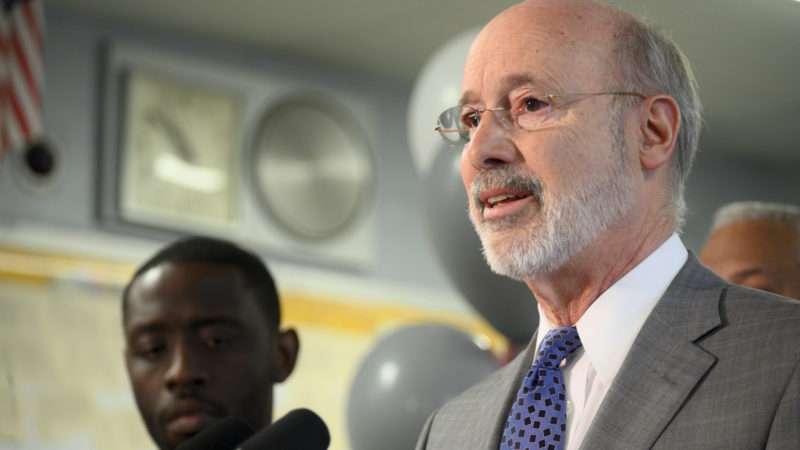I blogged below about the general analysis in Judge William S. Stickman IV’s decision in County of Butler v. Wolf (W.D. Pa.), as well as its application to the gatherings ban and the stay-at-home order. But the court also concluded that the business shutdown also violated substantive due process (as well as equal protection), because “The Fourteenth Amendment guarantees a citizen’s right to support himself by pursuing a chosen occupation”—and even if that right is subject only to rational basis scrutiny, the shutdown failed that scrutiny because it was too arbitrary:
The Supreme Court has recognized that the “core of the concept” of substantive due process is the protection against arbitrary government action. Indeed, “the touchstone of due process is protection of the individual against arbitrary actions of government ….” Rational basis review is a forgiving standard for government acts, but it “is not a toothless one ….” As a general matter, the rational basis test requires only that the governmental action “bear[] a rational relationship to some legitimate end.” Conversely, actions which are irrational, arbitrary or capricious do not bear a rational relationship to any end….
The record shows that the Governor’s advisory team, which designated the Business Plaintiffs and countless other businesses throughout the Commonwealth as “non-life-sustaining” and, thereby, closing them, did so with no set policy as to the designation and, indeed, without ever formulating a set definition for “life-sustaining” and, conversely “non-life-sustaining.” The terms “life-sustaining” and “non-life-sustaining” relative to businesses are not defined in any Pennsylvania statute or regulation…. The record demonstrates that the policy team’s unilateral determination as to which classes of businesses would be classified as “life-sustaining” was never formalized and the team never settled on a specific definition of “life-sustaining” ….
Mr. Robinson said that [the policy team] used the NAICS system to determine which businesses were “life-sustaining,” although the NAICS does not actually use that categorization. He acknowledged that the team simply applied their common-sense judgment as to what was, or was not, “life-sustaining.” In doing so, they did not confine themselves to “the formality of kind of enshrining a definition somewhere.” So, without a definition, how can one determine which businesses can stay open and which must close? Mr. Robinson said that one should look to the policy team’ s list (of “life-sustaining” businesses). Essentially, a class of business is “life-sustaining” if it is on the list and it is on the list because it is “life-sustaining.” …
The manner in which Defendants, through their policy team, designed, implemented, and administered the business closures is shockingly arbitrary. The policy team was not tasked with formulating a theoretical policy paper or standard to categorize abstract classes of business or NAICS codes. Rather, it had the authority to craft a policy, adopted wholesale by Defendants, that had an immediate impact on the Business Plaintiffs and countless other businesses, employers, and employees across the Commonwealth. Despite the fact that their decisions had the potential (and in many cases the actual effect) of destroying businesses and putting employees out of work, Defendants and their advisors never formulated a set, objective definition in writing of what constitutes “life-sustaining.”
The Court recognizes that Defendants were acting in haste to address a public health situation. But to the extent that Defendants were exercising raw governmental authority in a way that could (and did) critically wound or destroy the livelihoods of so many, the people of the Commonwealth at least deserved an objective plan, the ability to determine with certainty how the critical classifications were to be made, and a mechanism to challenge an alleged misclassification. The arbitrary design, implementation, and administration of the business shutdowns deprived the Business Plaintiffs and their fellow citizens of all three.
Another layer of arbitrariness inherent in the business shutdown components of Defendants’ orders are that many “non-life-sustaining” businesses sell the same products or perform the same services that were available in stores that were deemed “life-sustaining.” For example, Plaintiff R.W. McDonald & Sons is a small appliance and furniture store that was deemed a “non-life-sustaining” business and required to close. But larger retailers selling the same products, such as Lowes, The Home Depot, Walmart and others remained opened. Mr. McDonald stated that his business “lost approximately $300,000 in revenue” and that his business has been “financially devastated.” He also averred that he lost business to the big-box retailers that were permitted to remain in operation….
But the court rejected the equal protection challenge to the different reopening schedules in different regions:
The Court holds that Defendants had a rational basis for rolling out their reopening plan on a regional basis based on counties. Doing so recognized and respected the differences in population density, infrastructure and other factors relevant to the effort to address the virus. The Business Plaintiffs point to similarity between their area and neighboring counties permitted to open earlier, but rational basis does not require the granularity of a neighborhood by neighborhood plan. Distinctions between counties are a historically accepted manner of statewide administration and pass scrutiny here.
The court also held that the challenge to the shutdown order is not moot, even though it has been “suspended,” because it hasn’t been withdrawn outright and may yet be reinstated.
My sense is that the substantive argument invalidating the business shutdowns isn’t really consistent with the Court’s precedents on economic regulation and the rational basis test: Rightly or wrongly, the Court has held that the government has very broad authority in drawing lines when it comes to economic regulation (including regulation of the right to pursue one’s chosen occupation), and that seems to me to include making case-by-case decisions that may be hard to fit into a clearly articulable rule. I doubt that this part of the decision (or perhaps even the other parts) will survive on appeal, though I’ve been proved wrong in such predictions many times before.
from Latest – Reason.com https://ift.tt/33zA5pU
via IFTTT
